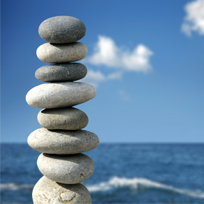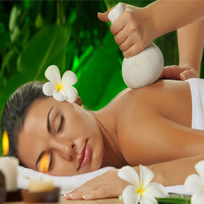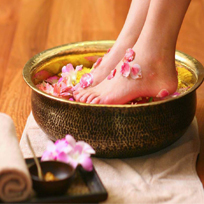
Hot Stone Massage
Stones (usually basalt) are placed into an electric slow-cooker or a purpose-built device which is filled with water. The water is typically heated to 52-54 degrees Celsius (122-127 degrees Fahrenheit).
Once the stones have heated sufficiently, some are placed onto specific points on the body (such as the back, hands, etc.) and others are held by the massage therapist and used to work the muscles.
Certain styles of stone massage also incorporate chilled stones into the routine. These stones are usually marble, and are placed into a bowl of iced water before use.
Thai Back Walking Massage
Traditional Thai massage uses no oils or lotions. The recipient remains clothed during a treatment. There is constant body contact between the giver and receiver, but rather than rubbing on muscles, the body is compressed, pulled, stretched and rocked.
The massage generally follows designated lines ("sen") in the body. The legs and feet of the giver can be used to position the body or limbs of the recipient. In other positions, hands fix the body, while the feet do the massaging. A full Thai massage session typically lasts two hours or more, and includes rhythmic pressing and stretching of the entire body. This may include pulling fingers, toes, ears, cracking knuckles, walking on the recipient's back, and moving the recipient's body into many different positions. There is a standard procedure and rhythm to the massage, which the giver will adjust to fit the receiver.


Foot Reflexology Massage
The Cochrane Collaboration defines reflexology as follows:"Reflexology is gentle manipulation or pressing on certain parts of the foot to produce an effect elsewhere in the body."
Reflexologists posit that the blockage of an energy field, invisible life force, or Qi, can prevent healing. Another tenet of reflexology is the belief that practitioners can relieve stress and pain in other parts of the body through the manipulation of the feet. One claimed explanation is that the pressure received in the feet may send signals that 'balance' the nervous system or release chemicals such as endorphins that reduce stress and pain. These hypotheses are rejected by the medical community, who cite a lack of scientific evidence and the well-tested germ theory of disease.